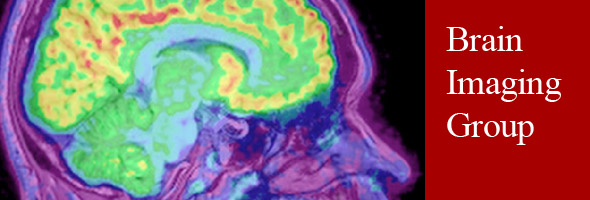 |
| The Brain Imaging Group uses advanced imaging modalities to investigate neuropsychiatric disorders and their treatment. The group makes important discoveries related to psychiatric disorders as well as developing new radioligands and techniques for quantification and analysis. |
| Pathophysiology and Treatment of Bipolar Disorder |
| Bipolar disorder (BPD) is a brain disorder characterized by recurrent manic and major depressive episodes with a one year prevalence rate between 1-2%.1 BPD ranked 20th in terms of causes of loss of disability- adjusted life-years in 19992 and is associated with a life time suicide risk of up to a 19%.3 The main burden of illness in BPD is in the depressive pole. A deficiency of serotonin (5-HT) function has been postulated to underlie depressive episodes yet few studies have examined indices of 5-HT neurotransmission in the brain in BPD. It is widely acknowledged that there are significant gaps in the current identification and treatment of bipolar depression.5-8 Better understanding of the neurotransmission deficits in BPD may aid diagnosis, identification of biomarkers and treatment targets to facilitate treatment development and ultimately to assist in treatment selection. Our preliminary data with [11C]DASB shows lower binding in BPD. We propose to determine the extent and nature of abnormalities of 5-HTT binding in vivo using positron emission tomography (PET) in medication-free bipolar I depression. We hypothesize that BPD has lower 5-HTT binding compared to controls. We will also investigate the 5-HT effects of a common treatment for BPD, lithium. Discovered decades ago, lithium remains one of the few effective treatments in BPD, with evidence of mood stabilizing, antidepressant, antisuicidal, and even neuroprotective qualities and is considered to be first line treatment. The actions of lithium on 5-HT indices may be central to its antidepressive and antisuicidal properties. We hypothesize that lithium downregulates presynaptic 5-HT1A receptor binding, upregulates postsynaptic 5-HT1A binding, upregulates 5-HTT binding, and these molecular effects will be related to clinical improvement, both in depression and suicidality. 5-HT1A binding potential will be determined using [11C]WAY 100635. We propose to perform [11C]DASB and [11C]WAY 100635 scans in 38 medication free BPD I subjects during a major depressive episode and compare 5-HTT and 5-HT1A binding potential in 38 healthy volunteers. We will also examine the diagnostic specificity of lithium response by studying 10 unipolar depressed subjects in an identical manner. We will examine the pharmacological specificity of lithium by studying lamotrigine in BPD subjects. Finally, we will also assess the ability of baseline scanning to predict treatment response. All BPD subjects will be treated with lithium and have repeat scans with both radiotracers. Many with BPD do not tolerate lithium´s side effect burden, and it has a narrow therapeutic window. In this grant period we will determine at which 5-HT protein(s) lithium exerts its antidepressant and antisuicidal properties. Ultimately this can lead to novel therapeutics that are better tolerated. We will independently advance our understanding of the molecular pathophysiology of BPD as well as characterize the mechanisms of action of lithium. Bipolar disorder or manic depressive illness is a very common and devastating brain illness. Very little is known about the biological basis of this illness and less is known about the mechanism of action of our commonly prescribed medications. With this proposal we will significantly increase our understanding of both the illness and its treatment using state of the art brain imaging technologies. |
| Characterization of a New Metabotropic Glutamate Receptor Subtype 5 PET Ligand |
|
Characterization of a New Metabotropic
Glutamate Receptor Subtype 5 PET Ligand
Brain Imaging Group Director, Christine
DeLorenzo, PhD, is the Principal Investigator on a grant that involves
characterizing the novel PET radioligand,
3-(6-Methyl-pyridin-2-ylethynyl)-cyclohex-2-enone-O-11Cmethyl-oxime
([11C]ABP688), an antagonist of the metabotropic glutamate receptor subtype 5
(mGluR5), in humans. A large body of diverse evidence implicates mGluR5 in the
pathophysiology of depression. Quantification of mGluR5 variation by
[11C]ABP688 could serve many purposes, from a possible indicator of depression
or other disorders, to a potential monitor of treatment effectiveness in an
individual, to providing personalized information prior to treatment about
potential therapeutic outcomes. However, as with any newly developed PET
tracer, [11C]ABP688 must be properly characterized in humans in order to
provide accurate quantification of its target. Specifically, the study will:
(1) determine the optimal modeling techniques and scanning time for
[11C]ABP688, to ensure reliable and accurate quantification; (2) examine
methods to calculate a full plasma input function without an arterial line,
improving subject comfort and decreasing scan cost; (3) investigate sensitivity
of [11C]ABP688 to endogenous glutamate to determine if this ligand can be used
to monitor glutamate level variations in neurologic and psychiatric disorders;
and (4) compare mGluR5 distribution and density in depressed and control
subjects. |
| Biosignature of Antidepressant Response |
|
The departments Brain Imaging Group participates
in a multi-site research project funded by the NIMH called EMBARC (Establishing
Moderators/Mediators for a Biosignature of Antidepressant Response in Clinical
Care). They are seeking biosignatures for
the personalized treatment of depression. Researchers hope to identify a
standard set of biomarkers and other measures that can be used to predict which
interventions will produce the best treatment outcomes for an individual. The
study is systematically collecting data on clinical moderators,
electrophysiology moderators, behavioral phenotyping moderators, neuroimaging
moderators, and blood samples. |
| Biomarkers of Major Depressive Disorder |
|
With a grant from the Irving
Institute for Clinical and Translational Research, the group combines several imaging modalities, using
advanced machine learning and statistical classification techniques that have
been successful in integrating large amounts of information in other fields.
Using these techniques may allow a deeper understanding of the pathophysiology
of depression and will lay the foundation for developing a neurobiologically
based system of classifying depression subtypes; potentially improving both
diagnosis and treatment.
|
| Reference region approaches in PET |
| The group, led in this project by Francesca Zanderigo, PhD, develops reference region approaches for positron emission tomography (PET) brain studies in order to obtain full quantification without arterial input function (IF) sampling, an invasive and costly procedure. Although they need a reliable RR and are only able to estimate the nondisplaceable binding potential (BP(ND)), RRAs are widely used. If quantitatively reliable, then RRAs can greatly benefit PET investigations, but their suitability can vary widely from radioligand to radioligand. This study compares estimates of BP(ND) both using IF data and several common RRAs on an extensive data set for each of several radioligands. In addition, two new methods, likelihood estimation in graphical analysis with RR and a bootstrapping algorithm for estimating precision, are presented here for the first time. Although many factors contribute to the performance of each RRA, our results suggest that the kinetics in the RR have a role. In particular, RRAs tend to be good when (1) the RR distribution volume is high; (2) the transfer rate constant from plasma to free compartment in the RR is high; and (3) the transfer rate constant from free to plasma compartment in the RR is low |
| Director of the Brain Imaging Group |
 Christine DeLorenzo, PhD, earned her doctoral degree in Biomedical Engineering at Yale University. After completing a Postdoctoral research fellowship in the Division of Molecular Imaging and Neuropathology at Columbia University, Dr. DeLorenzo was appointed Assistant Professor of Clinical Neurobiology at Columbia University. In 2012 she was appointed Assistant Professor of Psychiatry and Assistant Professor of Biomedical Engineering at Stony Brook University. Christine DeLorenzo, PhD, earned her doctoral degree in Biomedical Engineering at Yale University. After completing a Postdoctoral research fellowship in the Division of Molecular Imaging and Neuropathology at Columbia University, Dr. DeLorenzo was appointed Assistant Professor of Clinical Neurobiology at Columbia University. In 2012 she was appointed Assistant Professor of Psychiatry and Assistant Professor of Biomedical Engineering at Stony Brook University. |